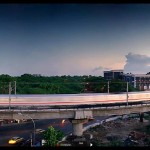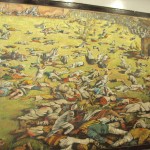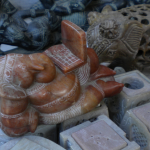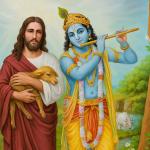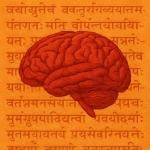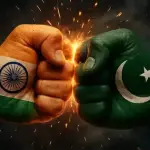Raj Kapoor, Dilip Kumar and Dev Anand combined to formed the trilogy of the Indian cinema in the 1950’s and 60’s. This is a rare picture ( from L to R you see Dilip Kumar, Raj Kapoor, Dev Anand) of all three in their hey days! Raj Kapoor is no longer alive. The picture is followed by a little bio of all three from the wikipedia – links at the beginning of this paragraph.
Interestingly, Raj Kapoor fashioned himself a lot on Charlie Chaplin and Dev Anand on Gregory Peck (he sometimes even resembled him). Dilip Kumar was the quintessential Tragedy King of the Indian Cinema who could flutter women’s hearts through his soulful dialogue delivery (see his starrer Devdas)!

On Raj Kapoor:
Raj Kapoor began his career as a clapper boy assisting Kidar Sharma. At age eleven, he appeared in films for the first time, in the 1935 film Inquilab. Raj Kapoor’s big break, however, came when he played the hero’s role in Neel Kamal (1947) by Kidar Sharma. In 1948, at the age of twenty-four, he established his own studio, R. K. Films, and became the youngest film director of his time. His first movie as a director Aag (Fire) (1948) was an immediate success.
Raj Kapoor’s career as director spanned the years from 1948 through 1988. He directed many films that are still remembered and loved, from Barsaat (1949) to Awaara (1951), Shri 420 (1955), and Sangam (1964). He starred in a number of the films he directed, often with actress Nargis, who was his real-life love interest.
After the box office failure of his ambitious 1970 film, Mera Naam Joker (My name is Joker), which took more than six years to complete, he produced and directed Bobby (1973) which was not only a huge box office success but also introduced Dimple Kapadia, later a very popular actress, and was the first of a new generation of teen romances. Dimple wore bikinis in the film which was quite unique for Indian films then. Raj Kapoor focussed a lot on the female form in later films like Satyam Shivam Sundaram (1978) and Ram Teri Ganga Maili (1985). His last film appearances were in Vakil Babu (1982) where he appeared opposite his brother Shashi Kapoor for the first and only time and a British made-for-television film Kim (1982).
Raj Kapoor suffered from asthma in his later years; he died of complications related to asthma in 1988 at sixty-three years of age. At the time of his death he was working on the movie Henna (an Indo-Pakistani love story). The film was later completed by his son Randhir Kapoor.
On Dilip Kumar:
His first film. Jwar Bhatta, was released in 1944. In 1949, he co-starred with Raj Kapoor in the film Andaz, which went to become a major success and made him a star. Tragic roles in popular films such as Deedar (1951) and Devdas (1955) earned him the title of “tragedy king”. The film Mughal-e-Azam (1960), in which he played crown-prince Jehangir, the son of Akbar, was also a huge hit. He produced and starred in the 1961 hit Ganga Jamuna. Despite the film’s success he did not produce any film after this.
Dilip had a narrow brush with wider fame in 1962, when British director David Lean offered him the role of Sherif Ali in his 1962 blockbuster, Lawrence of Arabia. However, Kumar declined the part. The role eventually went to Omar Sharif, the Egyptian actor.
In the 1970s, 1980s, and early 1990s, Dilip Kumar acted in fewer films. Newer actors had taken the spotlight. However, his many fans were still willing to go see him in the character roles he increasingly favoured. His notable films in the 1980s and early 90s included Kranti (1982), Shakti (1982), Karma (1986) and Saudagar (1991) which were very successful at the box office. After his last film appearance in Qila (1998) he retired from the film industry and hasn’t appeared in any film since.
Some of his older films have achieved the status of “evergreen classics”, shown over and over again on television or cherished on videotape and DVD. A few of them, such as Devdas, Ram Aur Shyam, and Ganga Jamuna, have been re-made several times. His film Mughal-e-Azam, which was originally released in black-and-white with several color scenes, was colorized in 2004 and re-released. Even in 2004, it did well at the box office.
On Dev Anand:
Dev Anand was born in Gurdaspur in Punjab to a well-to-do advocate, Pishorimal Anand. He graduated in English literature from the Government College, Lahore (now in Pakistan). His love for acting made him leave his hometown.Dev began his career in the military censor office at Churchgate, Mumbai, for a princely salary of Rs 160. He was soon offered a break as an actor by Prabhat Talkies to star in their Hum Ek Hain (1946). While shooting for the film in Pune, Dev struck a friendship with fellow actor Guru Dutt. Soon, they were swapping shirts, double dating and sharing dreams. They made a pact: if Dev produced a film, Guru Dutt would direct it; if Guru Dutt produced a film, Dev would act in it.
Dev made the grade first. By a strange coincidence, Dev was offered his first big break by Ashok Kumar, his favourite star. Kumar spotted Dev hanging around in the studios and picked him as hero for the Bombay Talkies production, Ziddi, costarring Kamini Kaushal (1948). His first success came with Ziddi (1948).
In 1949, he turned producer and launched his own “banner” Navketan, which continues to churn out movies year after year. Though his maiden attempt at direction, Prem Pujari, flopped, his second directorial effort Hare Rama Hare Krishna in the 1970’s with Zeenat Aman was a big success.
Dev never looked back. He bought his first car, a black Hillman. His dream of working with his teenage idol, actress Snehprabha Pradhan, was also fulfilled.
As promised, Dev gambled on Guru Dutt as director for the crime thriller, Baazi (1951). The dice rolled in favour of this creative collaboration; the Sahir [Ludhianvi, lyricist] song, Tadbeer se bigdi huyee taqdeer bana de, proved prophetic and Dev became a true blue star. It also crystallised his image as an urban cowboy with more than his share of smarts.
At this stage, Dev was drawn towards grey-shaded roles and films with a noirish flavour, like Jaal (1952). He played a gambler, a smuggler, a blackmarketeer. The year 1954 was a crucial one. Dev was one of the earliest Indian stars to visit Russia. His starrers, Rahee and Aandhiyan, were screened there along with Raj Kapoor’s Awaara.In the same year, Taxi Driver was declared a hit. Dev’s heroine was Kalpana Kartik again, and the two decided to marry in a quiet ceremony during a lunch break on the sets!
Marriage and the birth of son Suneil in 1956 did not affect Dev’s draw. A rapidfire style of dialogue delivery, an array of hats (remember Aye meri topi palat ke aa?), and a penchant for nodding while speaking became Dev’s USP in films like Munimji, CID and Paying Guest.
His style was lapped up by the audience and was widely imitated. He starred in a string of box office successes for the remainder of the 1950’s and some of his hit films include Munimji, CID, Paying Guest, Gambler, Tere Ghar ke Saamne and Kaala Pani.


